Toyota's Operations: Role of Leaders and Managers in Automotive
VerifiedAdded on 2021/01/01
|24
|4812
|474
Report
AI Summary
This report provides a comprehensive analysis of Toyota's operational management, leadership approaches, and key strategies within the automotive industry. It begins with an introduction to Toyota, highlighting its global presence and market position. The report then explores the roles of managers and leaders, contrasting their responsibilities and influences in various situations, including operational inefficiencies and conflicts. Different leadership models, such as the system approach and situational leadership, are evaluated for their effectiveness. The report also examines Toyota's key operational functions, including product design, and the application of lean manufacturing principles. Furthermore, it analyzes the impact of leaders and managers on the organization, discussing practices that enhance production efficiency. The report concludes with suggestions and recommendations for maintaining and improving Toyota's operational effectiveness, drawing on concepts like Jidoka and Just-In-Time production systems, and emphasizes the importance of continuous improvement and employee engagement in achieving organizational goals.
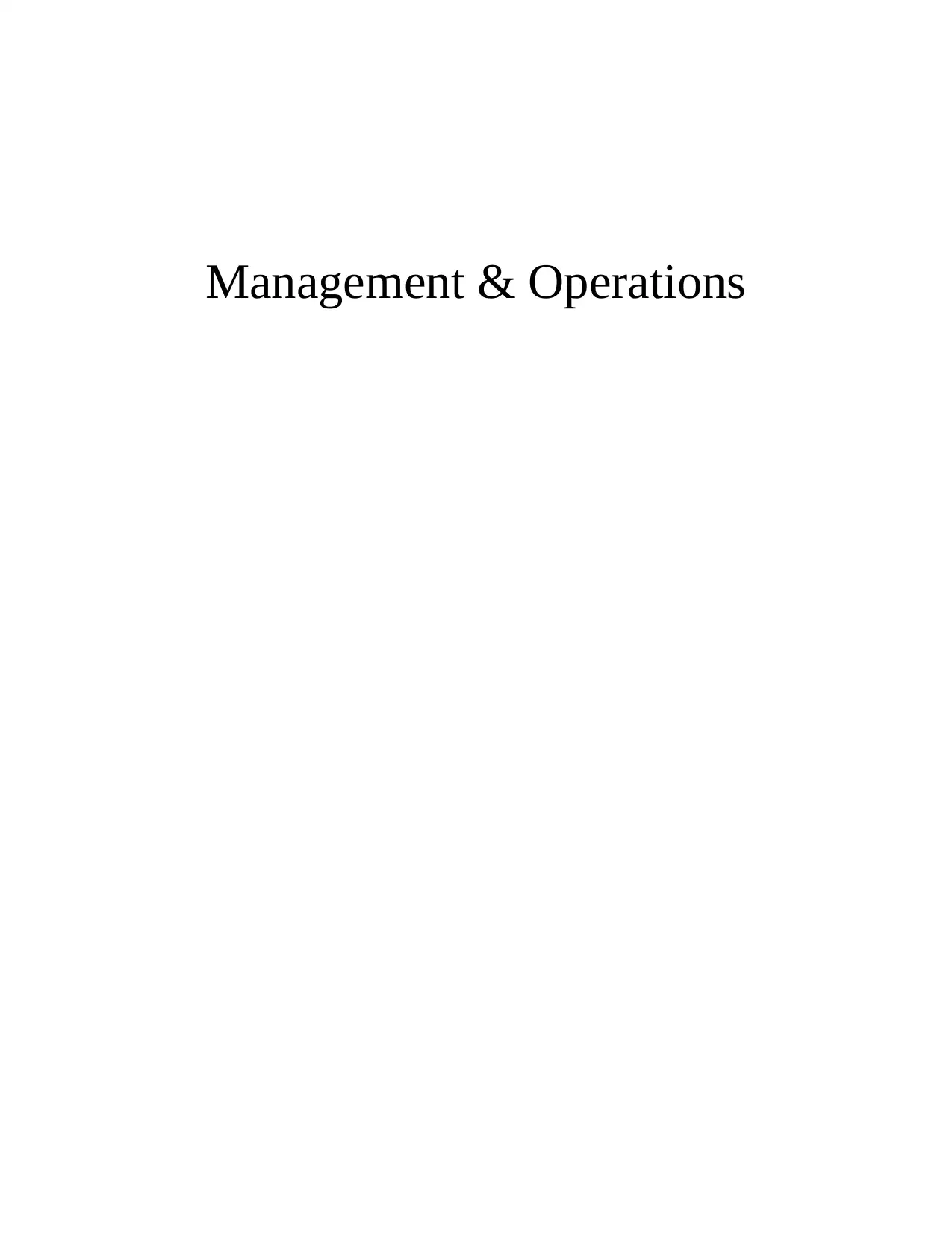
Management & Operations
Paraphrase This Document
Need a fresh take? Get an instant paraphrase of this document with our AI Paraphraser
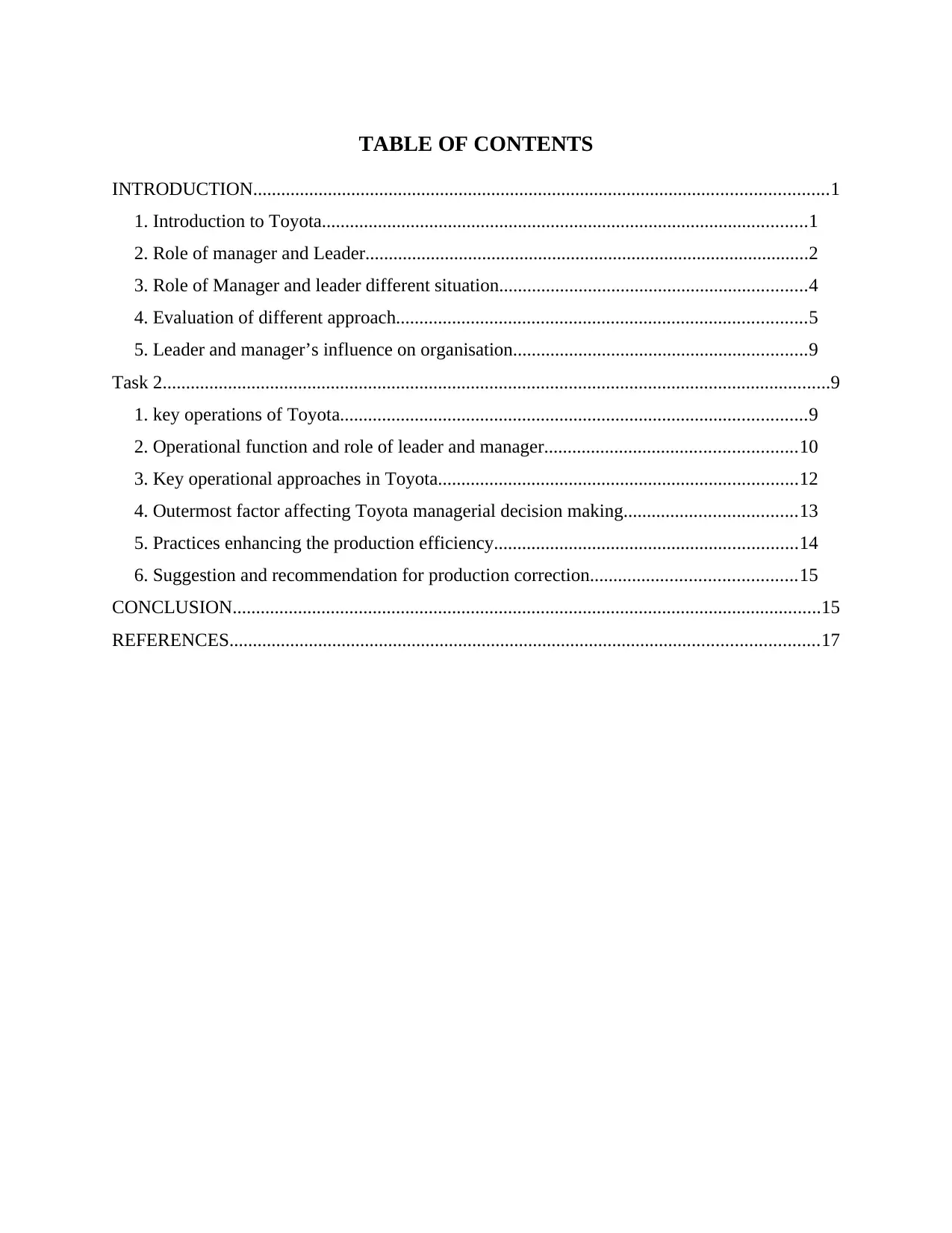
TABLE OF CONTENTS
INTRODUCTION...........................................................................................................................1
1. Introduction to Toyota........................................................................................................1
2. Role of manager and Leader...............................................................................................2
3. Role of Manager and leader different situation..................................................................4
4. Evaluation of different approach........................................................................................5
5. Leader and manager’s influence on organisation...............................................................9
Task 2...............................................................................................................................................9
1. key operations of Toyota....................................................................................................9
2. Operational function and role of leader and manager......................................................10
3. Key operational approaches in Toyota.............................................................................12
4. Outermost factor affecting Toyota managerial decision making.....................................13
5. Practices enhancing the production efficiency.................................................................14
6. Suggestion and recommendation for production correction............................................15
CONCLUSION..............................................................................................................................15
REFERENCES..............................................................................................................................17
INTRODUCTION...........................................................................................................................1
1. Introduction to Toyota........................................................................................................1
2. Role of manager and Leader...............................................................................................2
3. Role of Manager and leader different situation..................................................................4
4. Evaluation of different approach........................................................................................5
5. Leader and manager’s influence on organisation...............................................................9
Task 2...............................................................................................................................................9
1. key operations of Toyota....................................................................................................9
2. Operational function and role of leader and manager......................................................10
3. Key operational approaches in Toyota.............................................................................12
4. Outermost factor affecting Toyota managerial decision making.....................................13
5. Practices enhancing the production efficiency.................................................................14
6. Suggestion and recommendation for production correction............................................15
CONCLUSION..............................................................................................................................15
REFERENCES..............................................................................................................................17
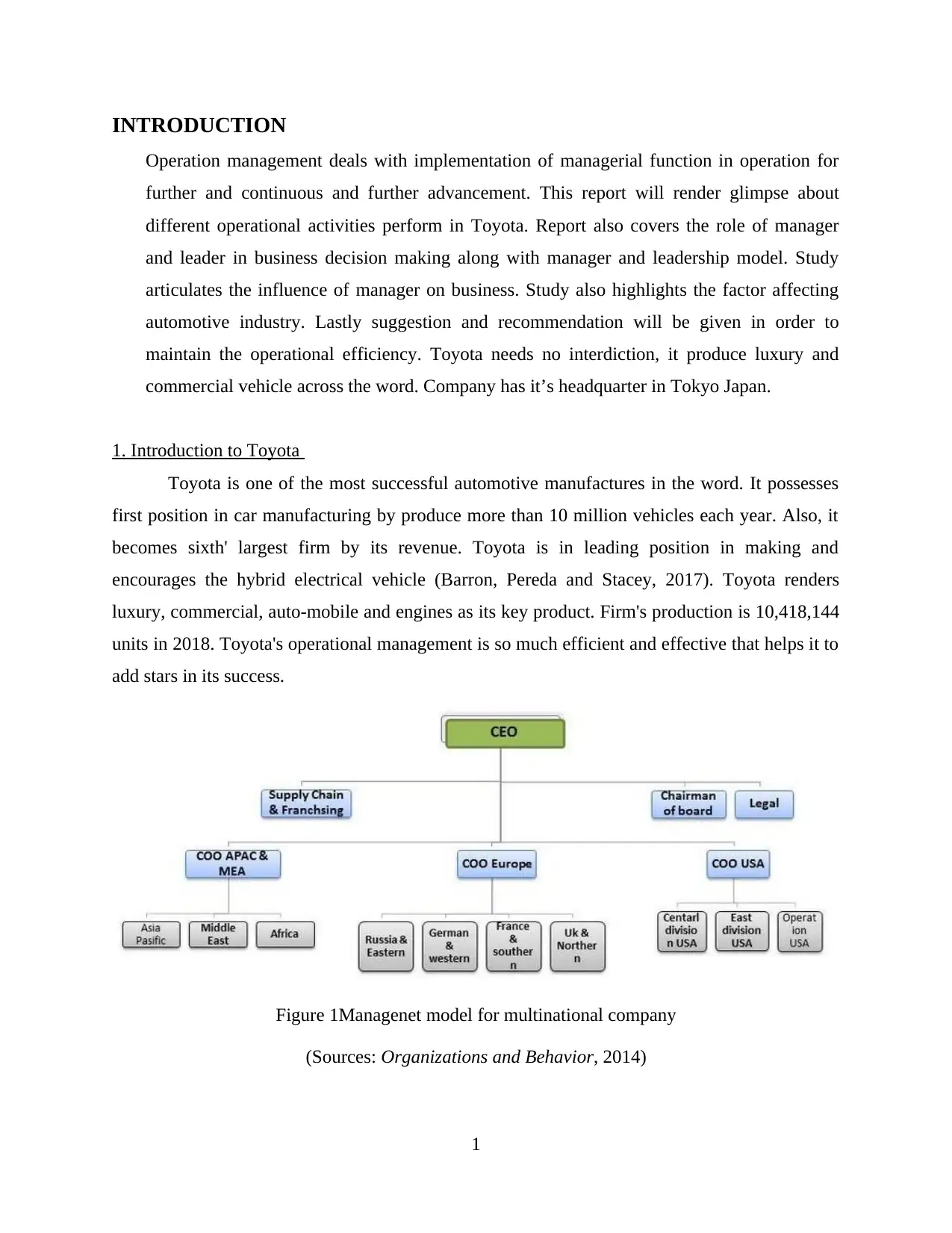
INTRODUCTION
Operation management deals with implementation of managerial function in operation for
further and continuous and further advancement. This report will render glimpse about
different operational activities perform in Toyota. Report also covers the role of manager
and leader in business decision making along with manager and leadership model. Study
articulates the influence of manager on business. Study also highlights the factor affecting
automotive industry. Lastly suggestion and recommendation will be given in order to
maintain the operational efficiency. Toyota needs no interdiction, it produce luxury and
commercial vehicle across the word. Company has it’s headquarter in Tokyo Japan.
1. Introduction to Toyota
Toyota is one of the most successful automotive manufactures in the word. It possesses
first position in car manufacturing by produce more than 10 million vehicles each year. Also, it
becomes sixth' largest firm by its revenue. Toyota is in leading position in making and
encourages the hybrid electrical vehicle (Barron, Pereda and Stacey, 2017). Toyota renders
luxury, commercial, auto-mobile and engines as its key product. Firm's production is 10,418,144
units in 2018. Toyota's operational management is so much efficient and effective that helps it to
add stars in its success.
Figure 1Managenet model for multinational company
(Sources: Organizations and Behavior, 2014)
1
Operation management deals with implementation of managerial function in operation for
further and continuous and further advancement. This report will render glimpse about
different operational activities perform in Toyota. Report also covers the role of manager
and leader in business decision making along with manager and leadership model. Study
articulates the influence of manager on business. Study also highlights the factor affecting
automotive industry. Lastly suggestion and recommendation will be given in order to
maintain the operational efficiency. Toyota needs no interdiction, it produce luxury and
commercial vehicle across the word. Company has it’s headquarter in Tokyo Japan.
1. Introduction to Toyota
Toyota is one of the most successful automotive manufactures in the word. It possesses
first position in car manufacturing by produce more than 10 million vehicles each year. Also, it
becomes sixth' largest firm by its revenue. Toyota is in leading position in making and
encourages the hybrid electrical vehicle (Barron, Pereda and Stacey, 2017). Toyota renders
luxury, commercial, auto-mobile and engines as its key product. Firm's production is 10,418,144
units in 2018. Toyota's operational management is so much efficient and effective that helps it to
add stars in its success.
Figure 1Managenet model for multinational company
(Sources: Organizations and Behavior, 2014)
1
⊘ This is a preview!⊘
Do you want full access?
Subscribe today to unlock all pages.

Trusted by 1+ million students worldwide
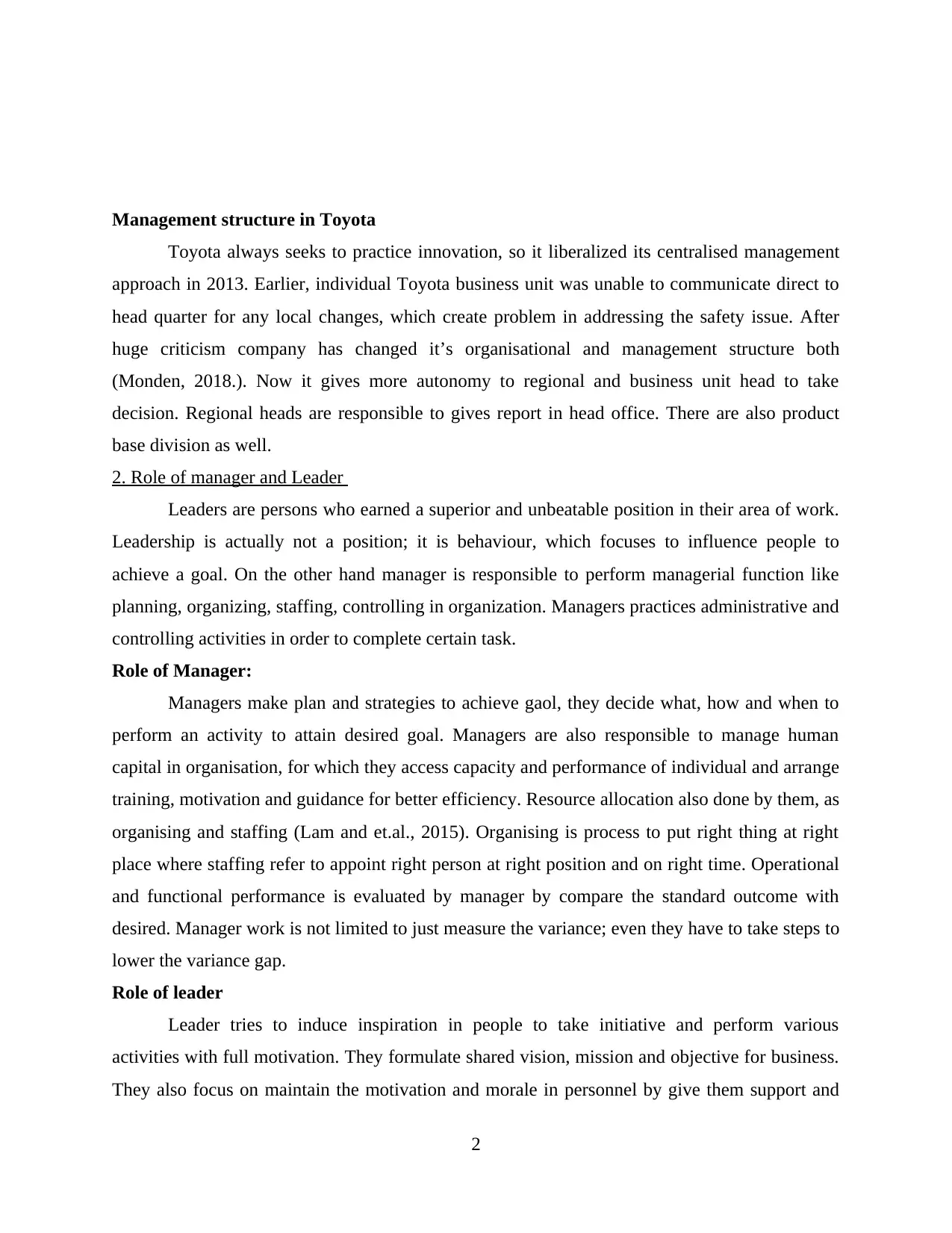
Management structure in Toyota
Toyota always seeks to practice innovation, so it liberalized its centralised management
approach in 2013. Earlier, individual Toyota business unit was unable to communicate direct to
head quarter for any local changes, which create problem in addressing the safety issue. After
huge criticism company has changed it’s organisational and management structure both
(Monden, 2018.). Now it gives more autonomy to regional and business unit head to take
decision. Regional heads are responsible to gives report in head office. There are also product
base division as well.
2. Role of manager and Leader
Leaders are persons who earned a superior and unbeatable position in their area of work.
Leadership is actually not a position; it is behaviour, which focuses to influence people to
achieve a goal. On the other hand manager is responsible to perform managerial function like
planning, organizing, staffing, controlling in organization. Managers practices administrative and
controlling activities in order to complete certain task.
Role of Manager:
Managers make plan and strategies to achieve gaol, they decide what, how and when to
perform an activity to attain desired goal. Managers are also responsible to manage human
capital in organisation, for which they access capacity and performance of individual and arrange
training, motivation and guidance for better efficiency. Resource allocation also done by them, as
organising and staffing (Lam and et.al., 2015). Organising is process to put right thing at right
place where staffing refer to appoint right person at right position and on right time. Operational
and functional performance is evaluated by manager by compare the standard outcome with
desired. Manager work is not limited to just measure the variance; even they have to take steps to
lower the variance gap.
Role of leader
Leader tries to induce inspiration in people to take initiative and perform various
activities with full motivation. They formulate shared vision, mission and objective for business.
They also focus on maintain the motivation and morale in personnel by give them support and
2
Toyota always seeks to practice innovation, so it liberalized its centralised management
approach in 2013. Earlier, individual Toyota business unit was unable to communicate direct to
head quarter for any local changes, which create problem in addressing the safety issue. After
huge criticism company has changed it’s organisational and management structure both
(Monden, 2018.). Now it gives more autonomy to regional and business unit head to take
decision. Regional heads are responsible to gives report in head office. There are also product
base division as well.
2. Role of manager and Leader
Leaders are persons who earned a superior and unbeatable position in their area of work.
Leadership is actually not a position; it is behaviour, which focuses to influence people to
achieve a goal. On the other hand manager is responsible to perform managerial function like
planning, organizing, staffing, controlling in organization. Managers practices administrative and
controlling activities in order to complete certain task.
Role of Manager:
Managers make plan and strategies to achieve gaol, they decide what, how and when to
perform an activity to attain desired goal. Managers are also responsible to manage human
capital in organisation, for which they access capacity and performance of individual and arrange
training, motivation and guidance for better efficiency. Resource allocation also done by them, as
organising and staffing (Lam and et.al., 2015). Organising is process to put right thing at right
place where staffing refer to appoint right person at right position and on right time. Operational
and functional performance is evaluated by manager by compare the standard outcome with
desired. Manager work is not limited to just measure the variance; even they have to take steps to
lower the variance gap.
Role of leader
Leader tries to induce inspiration in people to take initiative and perform various
activities with full motivation. They formulate shared vision, mission and objective for business.
They also focus on maintain the motivation and morale in personnel by give them support and
2
Paraphrase This Document
Need a fresh take? Get an instant paraphrase of this document with our AI Paraphraser
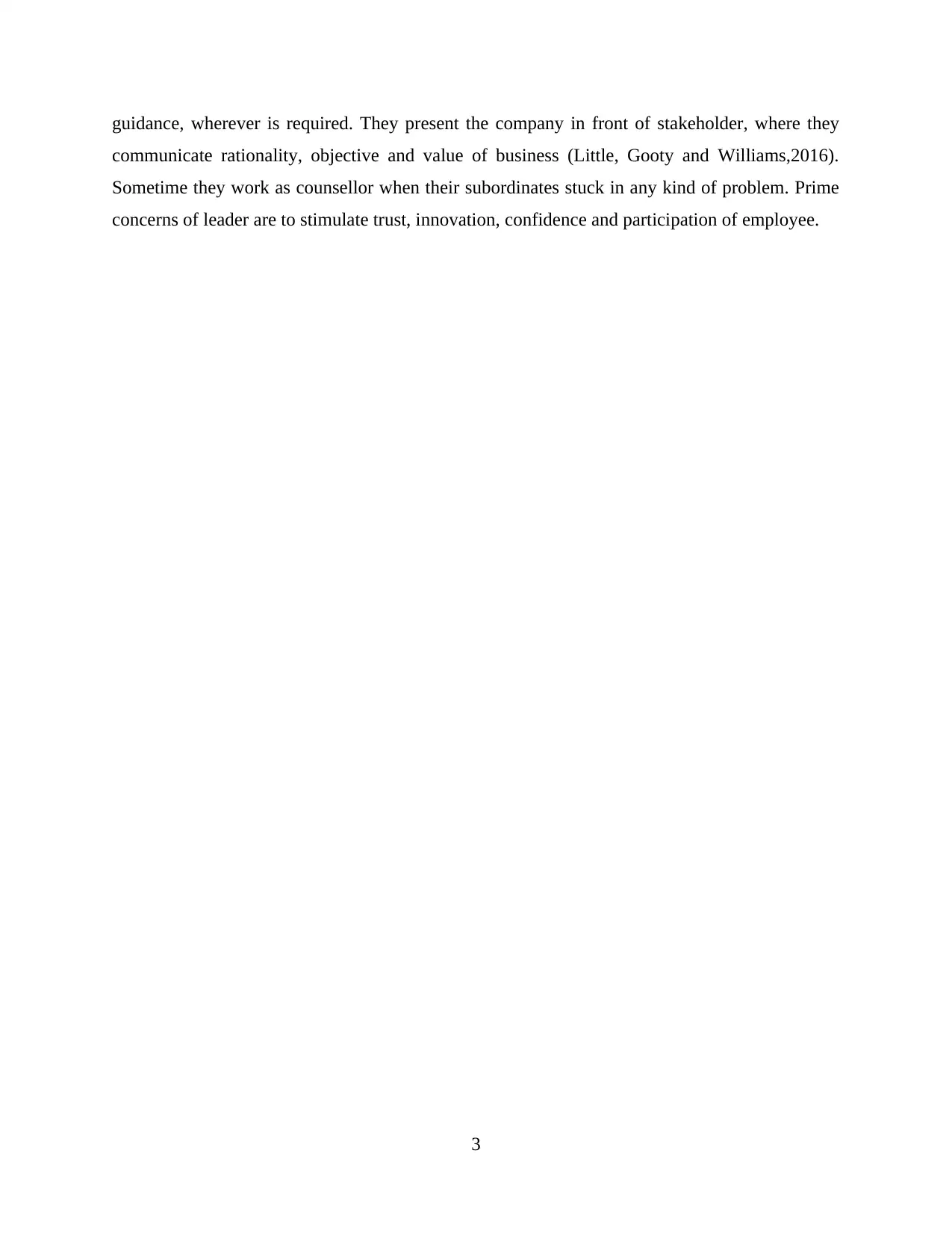
guidance, wherever is required. They present the company in front of stakeholder, where they
communicate rationality, objective and value of business (Little, Gooty and Williams,2016).
Sometime they work as counsellor when their subordinates stuck in any kind of problem. Prime
concerns of leader are to stimulate trust, innovation, confidence and participation of employee.
3
communicate rationality, objective and value of business (Little, Gooty and Williams,2016).
Sometime they work as counsellor when their subordinates stuck in any kind of problem. Prime
concerns of leader are to stimulate trust, innovation, confidence and participation of employee.
3
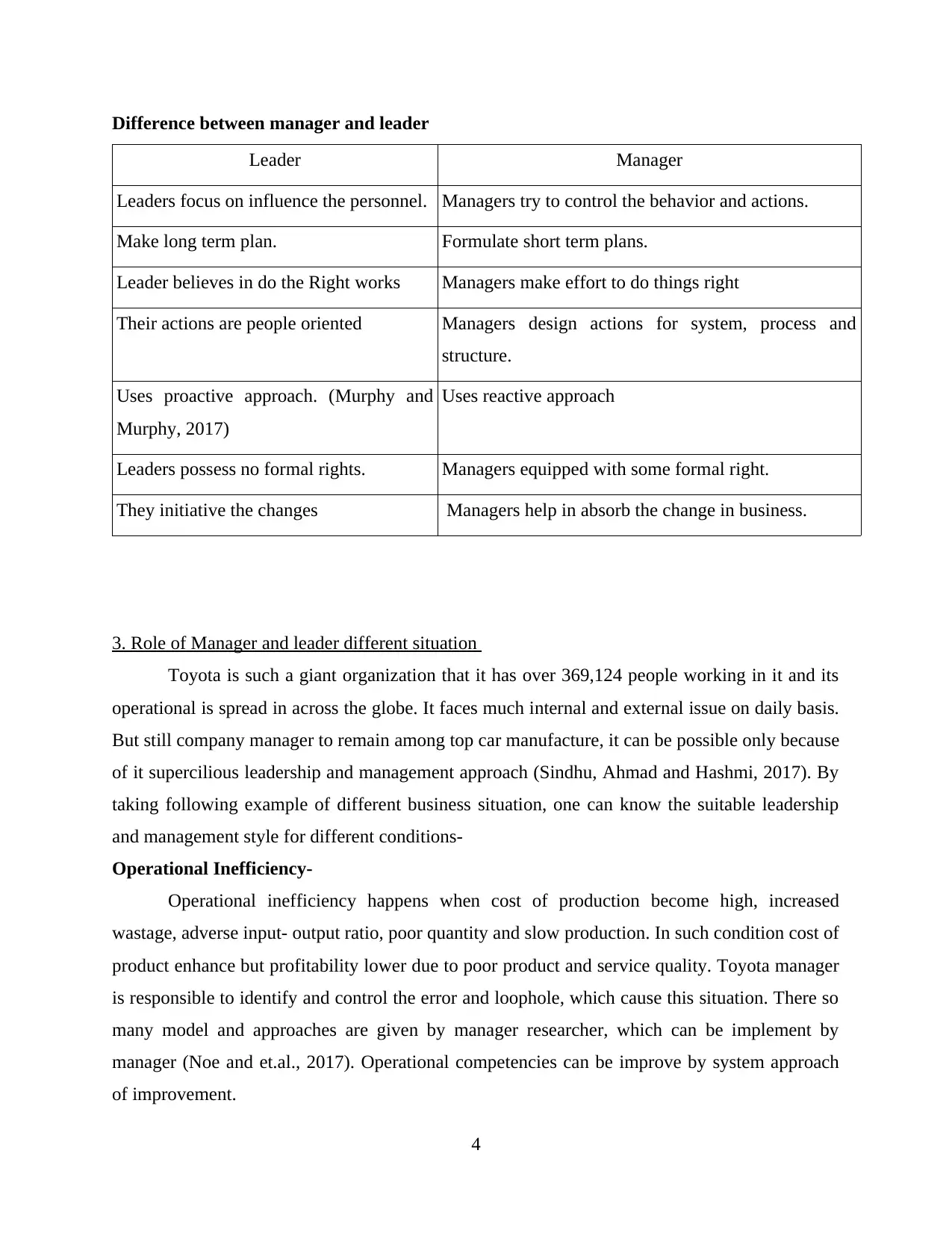
Difference between manager and leader
Leader Manager
Leaders focus on influence the personnel. Managers try to control the behavior and actions.
Make long term plan. Formulate short term plans.
Leader believes in do the Right works Managers make effort to do things right
Their actions are people oriented Managers design actions for system, process and
structure.
Uses proactive approach. (Murphy and
Murphy, 2017)
Uses reactive approach
Leaders possess no formal rights. Managers equipped with some formal right.
They initiative the changes Managers help in absorb the change in business.
3. Role of Manager and leader different situation
Toyota is such a giant organization that it has over 369,124 people working in it and its
operational is spread in across the globe. It faces much internal and external issue on daily basis.
But still company manager to remain among top car manufacture, it can be possible only because
of it supercilious leadership and management approach (Sindhu, Ahmad and Hashmi, 2017). By
taking following example of different business situation, one can know the suitable leadership
and management style for different conditions-
Operational Inefficiency-
Operational inefficiency happens when cost of production become high, increased
wastage, adverse input- output ratio, poor quantity and slow production. In such condition cost of
product enhance but profitability lower due to poor product and service quality. Toyota manager
is responsible to identify and control the error and loophole, which cause this situation. There so
many model and approaches are given by manager researcher, which can be implement by
manager (Noe and et.al., 2017). Operational competencies can be improve by system approach
of improvement.
4
Leader Manager
Leaders focus on influence the personnel. Managers try to control the behavior and actions.
Make long term plan. Formulate short term plans.
Leader believes in do the Right works Managers make effort to do things right
Their actions are people oriented Managers design actions for system, process and
structure.
Uses proactive approach. (Murphy and
Murphy, 2017)
Uses reactive approach
Leaders possess no formal rights. Managers equipped with some formal right.
They initiative the changes Managers help in absorb the change in business.
3. Role of Manager and leader different situation
Toyota is such a giant organization that it has over 369,124 people working in it and its
operational is spread in across the globe. It faces much internal and external issue on daily basis.
But still company manager to remain among top car manufacture, it can be possible only because
of it supercilious leadership and management approach (Sindhu, Ahmad and Hashmi, 2017). By
taking following example of different business situation, one can know the suitable leadership
and management style for different conditions-
Operational Inefficiency-
Operational inefficiency happens when cost of production become high, increased
wastage, adverse input- output ratio, poor quantity and slow production. In such condition cost of
product enhance but profitability lower due to poor product and service quality. Toyota manager
is responsible to identify and control the error and loophole, which cause this situation. There so
many model and approaches are given by manager researcher, which can be implement by
manager (Noe and et.al., 2017). Operational competencies can be improve by system approach
of improvement.
4
⊘ This is a preview!⊘
Do you want full access?
Subscribe today to unlock all pages.

Trusted by 1+ million students worldwide
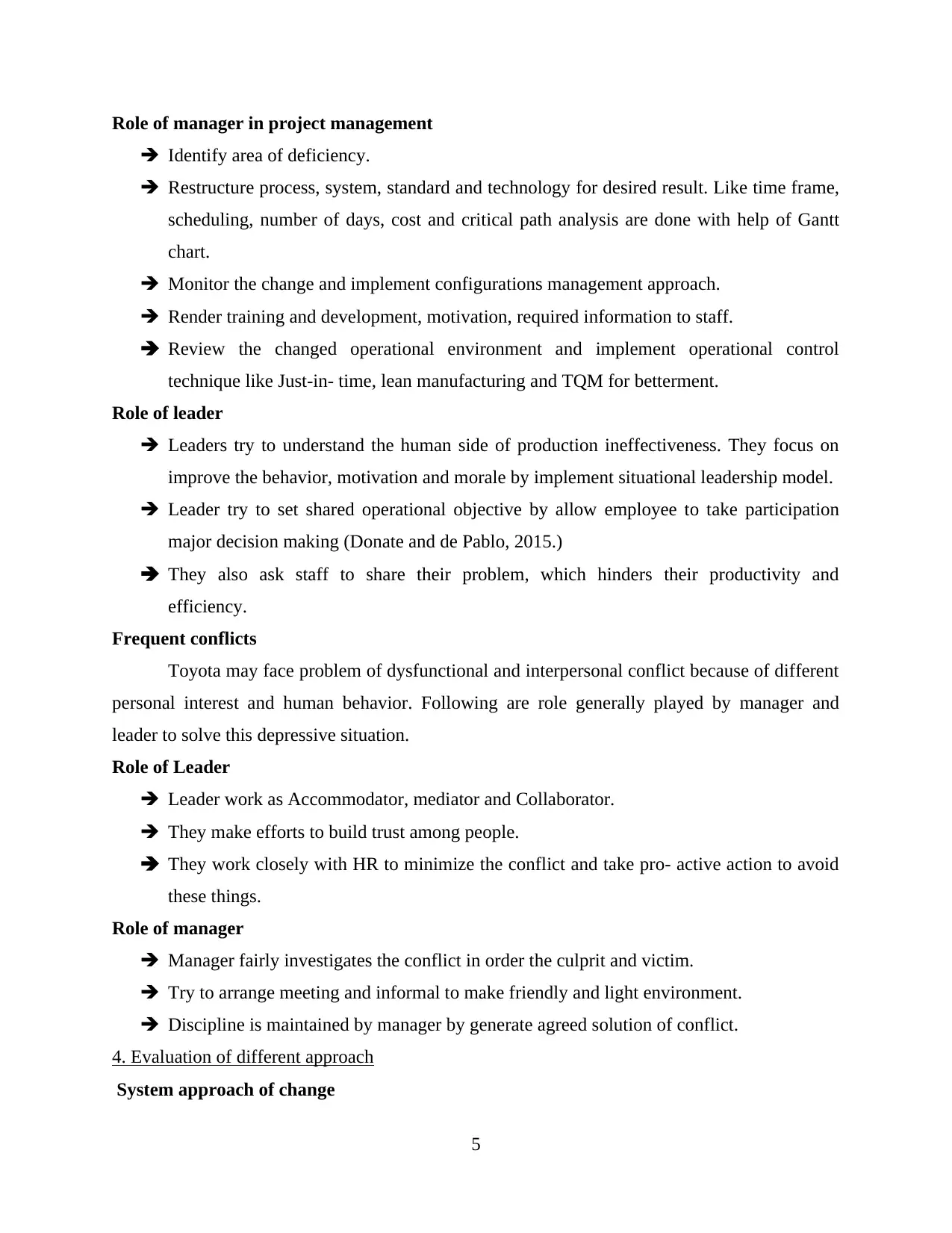
Role of manager in project management
Identify area of deficiency.
Restructure process, system, standard and technology for desired result. Like time frame,
scheduling, number of days, cost and critical path analysis are done with help of Gantt
chart.
Monitor the change and implement configurations management approach.
Render training and development, motivation, required information to staff.
Review the changed operational environment and implement operational control
technique like Just-in- time, lean manufacturing and TQM for betterment.
Role of leader
Leaders try to understand the human side of production ineffectiveness. They focus on
improve the behavior, motivation and morale by implement situational leadership model.
Leader try to set shared operational objective by allow employee to take participation
major decision making (Donate and de Pablo, 2015.)
They also ask staff to share their problem, which hinders their productivity and
efficiency.
Frequent conflicts
Toyota may face problem of dysfunctional and interpersonal conflict because of different
personal interest and human behavior. Following are role generally played by manager and
leader to solve this depressive situation.
Role of Leader
Leader work as Accommodator, mediator and Collaborator.
They make efforts to build trust among people.
They work closely with HR to minimize the conflict and take pro- active action to avoid
these things.
Role of manager
Manager fairly investigates the conflict in order the culprit and victim.
Try to arrange meeting and informal to make friendly and light environment.
Discipline is maintained by manager by generate agreed solution of conflict.
4. Evaluation of different approach
System approach of change
5
Identify area of deficiency.
Restructure process, system, standard and technology for desired result. Like time frame,
scheduling, number of days, cost and critical path analysis are done with help of Gantt
chart.
Monitor the change and implement configurations management approach.
Render training and development, motivation, required information to staff.
Review the changed operational environment and implement operational control
technique like Just-in- time, lean manufacturing and TQM for betterment.
Role of leader
Leaders try to understand the human side of production ineffectiveness. They focus on
improve the behavior, motivation and morale by implement situational leadership model.
Leader try to set shared operational objective by allow employee to take participation
major decision making (Donate and de Pablo, 2015.)
They also ask staff to share their problem, which hinders their productivity and
efficiency.
Frequent conflicts
Toyota may face problem of dysfunctional and interpersonal conflict because of different
personal interest and human behavior. Following are role generally played by manager and
leader to solve this depressive situation.
Role of Leader
Leader work as Accommodator, mediator and Collaborator.
They make efforts to build trust among people.
They work closely with HR to minimize the conflict and take pro- active action to avoid
these things.
Role of manager
Manager fairly investigates the conflict in order the culprit and victim.
Try to arrange meeting and informal to make friendly and light environment.
Discipline is maintained by manager by generate agreed solution of conflict.
4. Evaluation of different approach
System approach of change
5
Paraphrase This Document
Need a fresh take? Get an instant paraphrase of this document with our AI Paraphraser
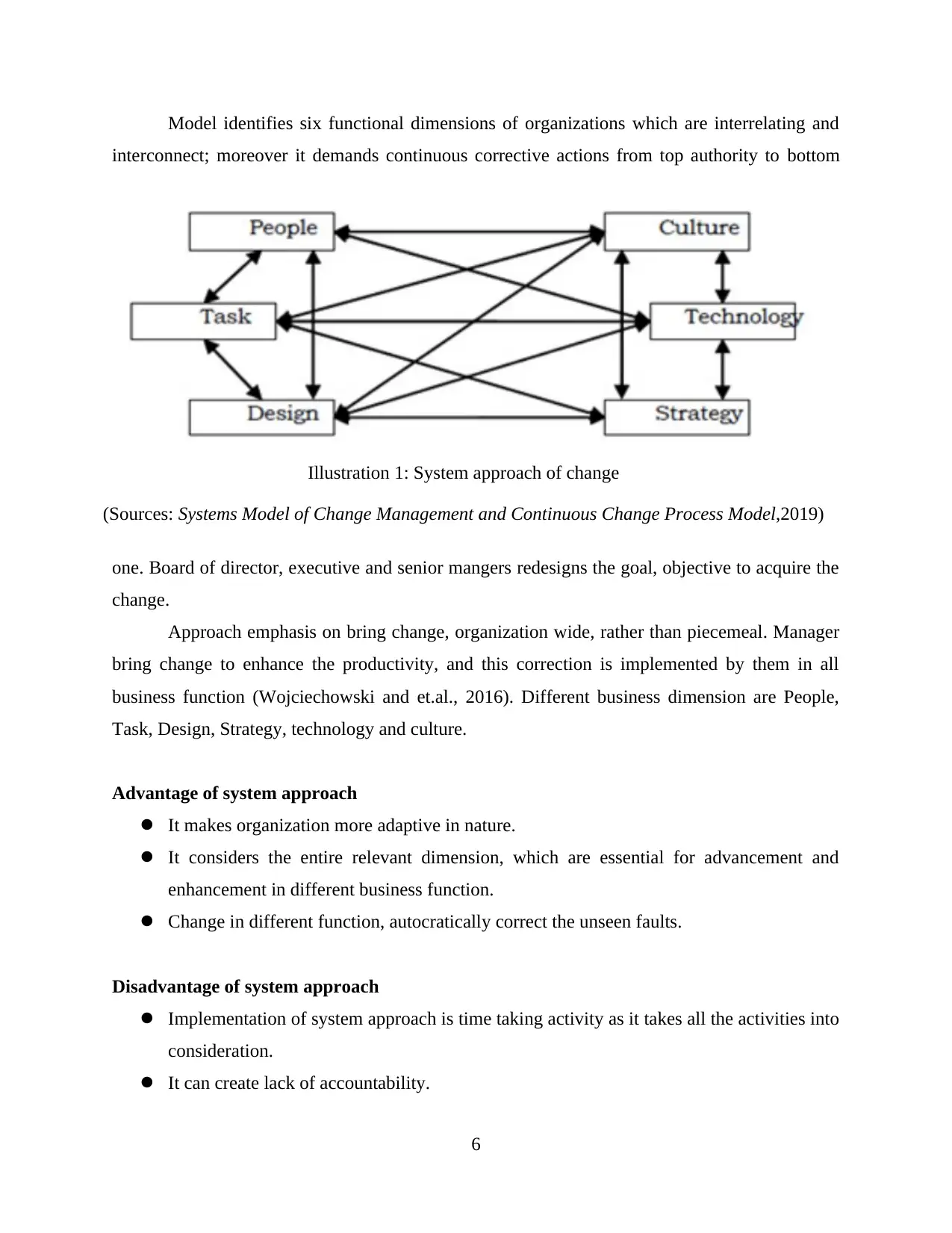
Model identifies six functional dimensions of organizations which are interrelating and
interconnect; moreover it demands continuous corrective actions from top authority to bottom
one. Board of director, executive and senior mangers redesigns the goal, objective to acquire the
change.
Approach emphasis on bring change, organization wide, rather than piecemeal. Manager
bring change to enhance the productivity, and this correction is implemented by them in all
business function (Wojciechowski and et.al., 2016). Different business dimension are People,
Task, Design, Strategy, technology and culture.
Advantage of system approach
It makes organization more adaptive in nature.
It considers the entire relevant dimension, which are essential for advancement and
enhancement in different business function.
Change in different function, autocratically correct the unseen faults.
Disadvantage of system approach
Implementation of system approach is time taking activity as it takes all the activities into
consideration.
It can create lack of accountability.
6
Illustration 1: System approach of change
(Sources: Systems Model of Change Management and Continuous Change Process Model,2019)
interconnect; moreover it demands continuous corrective actions from top authority to bottom
one. Board of director, executive and senior mangers redesigns the goal, objective to acquire the
change.
Approach emphasis on bring change, organization wide, rather than piecemeal. Manager
bring change to enhance the productivity, and this correction is implemented by them in all
business function (Wojciechowski and et.al., 2016). Different business dimension are People,
Task, Design, Strategy, technology and culture.
Advantage of system approach
It makes organization more adaptive in nature.
It considers the entire relevant dimension, which are essential for advancement and
enhancement in different business function.
Change in different function, autocratically correct the unseen faults.
Disadvantage of system approach
Implementation of system approach is time taking activity as it takes all the activities into
consideration.
It can create lack of accountability.
6
Illustration 1: System approach of change
(Sources: Systems Model of Change Management and Continuous Change Process Model,2019)
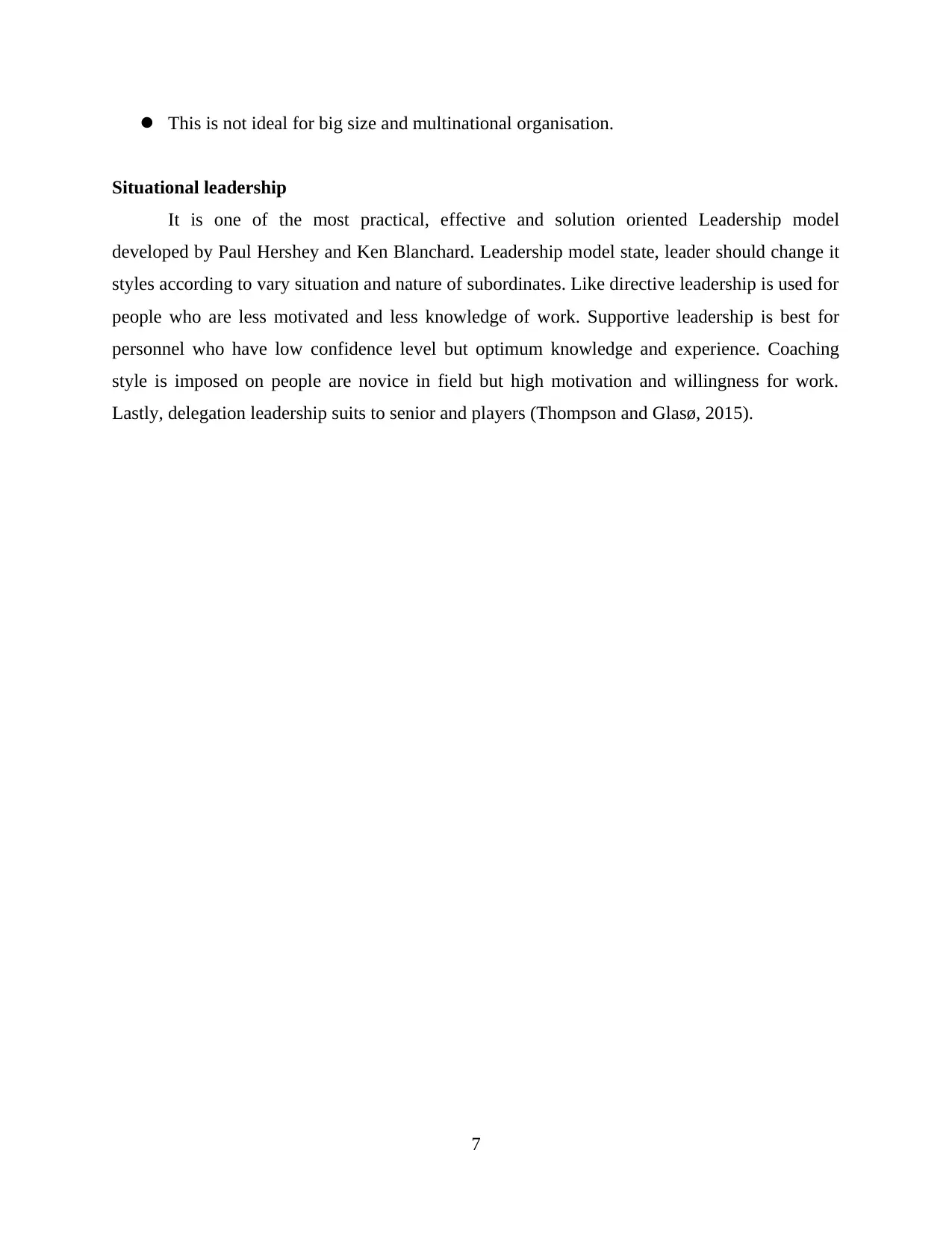
This is not ideal for big size and multinational organisation.
Situational leadership
It is one of the most practical, effective and solution oriented Leadership model
developed by Paul Hershey and Ken Blanchard. Leadership model state, leader should change it
styles according to vary situation and nature of subordinates. Like directive leadership is used for
people who are less motivated and less knowledge of work. Supportive leadership is best for
personnel who have low confidence level but optimum knowledge and experience. Coaching
style is imposed on people are novice in field but high motivation and willingness for work.
Lastly, delegation leadership suits to senior and players (Thompson and Glasø, 2015).
7
Situational leadership
It is one of the most practical, effective and solution oriented Leadership model
developed by Paul Hershey and Ken Blanchard. Leadership model state, leader should change it
styles according to vary situation and nature of subordinates. Like directive leadership is used for
people who are less motivated and less knowledge of work. Supportive leadership is best for
personnel who have low confidence level but optimum knowledge and experience. Coaching
style is imposed on people are novice in field but high motivation and willingness for work.
Lastly, delegation leadership suits to senior and players (Thompson and Glasø, 2015).
7
⊘ This is a preview!⊘
Do you want full access?
Subscribe today to unlock all pages.

Trusted by 1+ million students worldwide
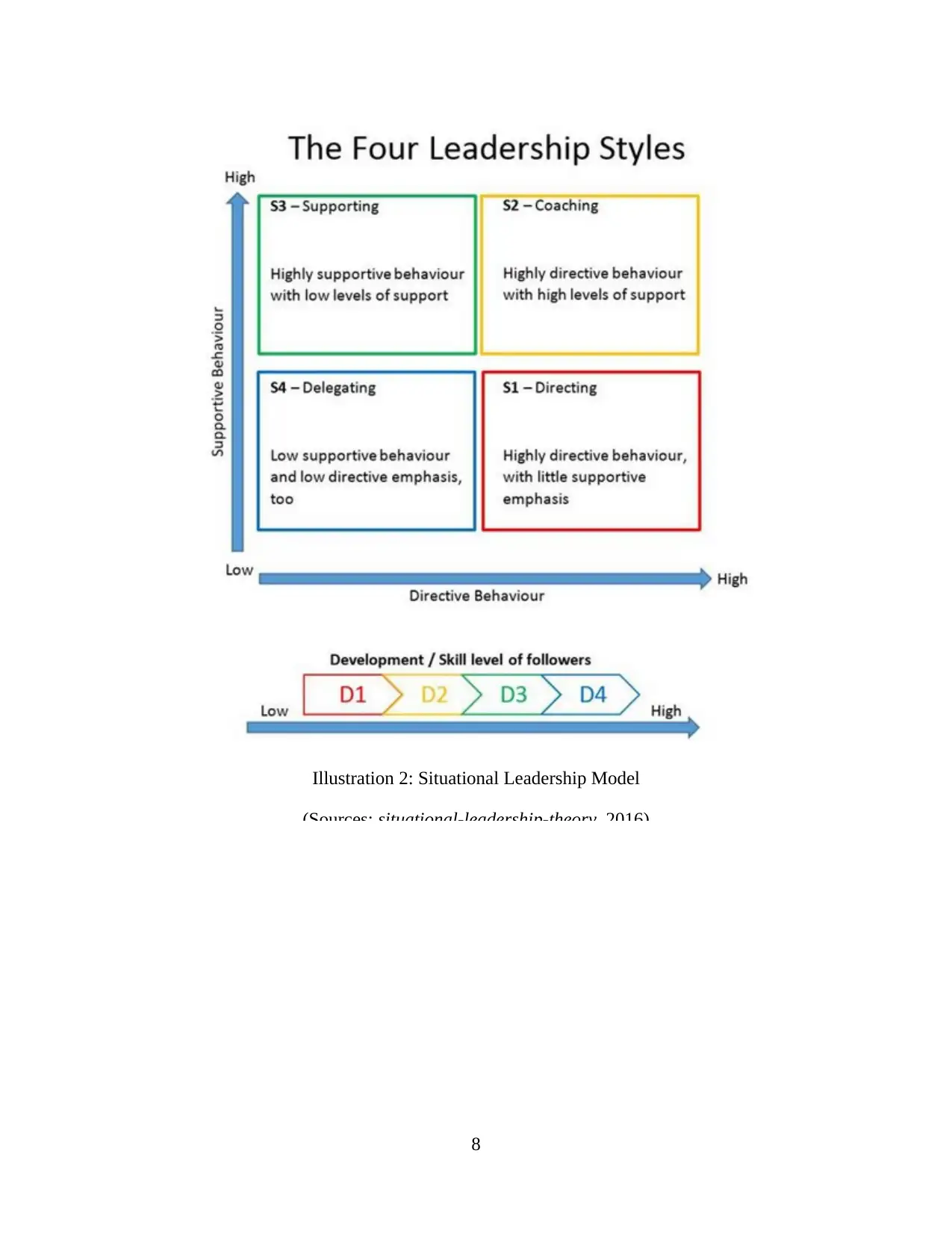
8
Illustration 2: Situational Leadership Model
(Sources: situational-leadership-theory, 2016)
Illustration 2: Situational Leadership Model
(Sources: situational-leadership-theory, 2016)
Paraphrase This Document
Need a fresh take? Get an instant paraphrase of this document with our AI Paraphraser
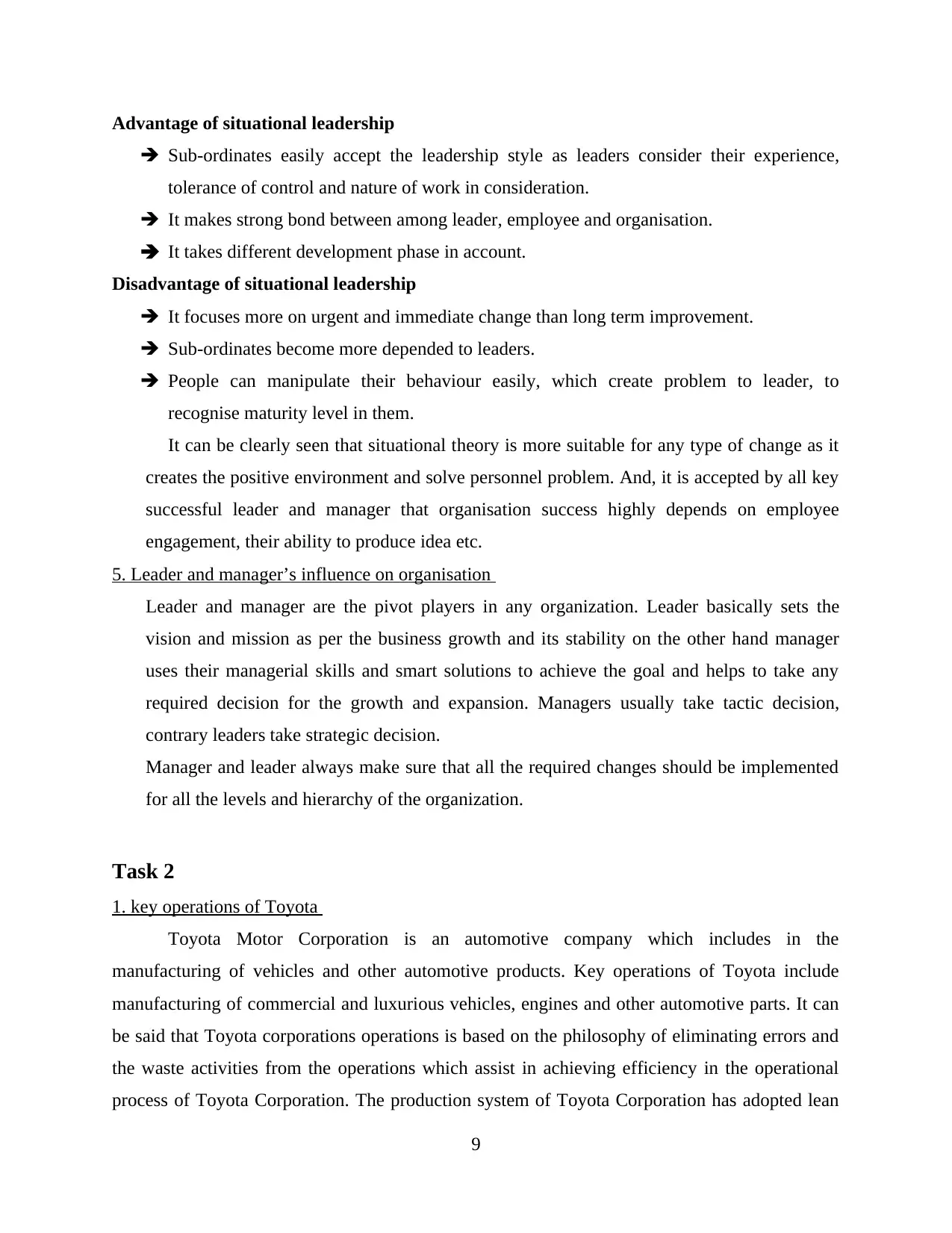
Advantage of situational leadership
Sub-ordinates easily accept the leadership style as leaders consider their experience,
tolerance of control and nature of work in consideration.
It makes strong bond between among leader, employee and organisation.
It takes different development phase in account.
Disadvantage of situational leadership
It focuses more on urgent and immediate change than long term improvement.
Sub-ordinates become more depended to leaders.
People can manipulate their behaviour easily, which create problem to leader, to
recognise maturity level in them.
It can be clearly seen that situational theory is more suitable for any type of change as it
creates the positive environment and solve personnel problem. And, it is accepted by all key
successful leader and manager that organisation success highly depends on employee
engagement, their ability to produce idea etc.
5. Leader and manager’s influence on organisation
Leader and manager are the pivot players in any organization. Leader basically sets the
vision and mission as per the business growth and its stability on the other hand manager
uses their managerial skills and smart solutions to achieve the goal and helps to take any
required decision for the growth and expansion. Managers usually take tactic decision,
contrary leaders take strategic decision.
Manager and leader always make sure that all the required changes should be implemented
for all the levels and hierarchy of the organization.
Task 2
1. key operations of Toyota
Toyota Motor Corporation is an automotive company which includes in the
manufacturing of vehicles and other automotive products. Key operations of Toyota include
manufacturing of commercial and luxurious vehicles, engines and other automotive parts. It can
be said that Toyota corporations operations is based on the philosophy of eliminating errors and
the waste activities from the operations which assist in achieving efficiency in the operational
process of Toyota Corporation. The production system of Toyota Corporation has adopted lean
9
Sub-ordinates easily accept the leadership style as leaders consider their experience,
tolerance of control and nature of work in consideration.
It makes strong bond between among leader, employee and organisation.
It takes different development phase in account.
Disadvantage of situational leadership
It focuses more on urgent and immediate change than long term improvement.
Sub-ordinates become more depended to leaders.
People can manipulate their behaviour easily, which create problem to leader, to
recognise maturity level in them.
It can be clearly seen that situational theory is more suitable for any type of change as it
creates the positive environment and solve personnel problem. And, it is accepted by all key
successful leader and manager that organisation success highly depends on employee
engagement, their ability to produce idea etc.
5. Leader and manager’s influence on organisation
Leader and manager are the pivot players in any organization. Leader basically sets the
vision and mission as per the business growth and its stability on the other hand manager
uses their managerial skills and smart solutions to achieve the goal and helps to take any
required decision for the growth and expansion. Managers usually take tactic decision,
contrary leaders take strategic decision.
Manager and leader always make sure that all the required changes should be implemented
for all the levels and hierarchy of the organization.
Task 2
1. key operations of Toyota
Toyota Motor Corporation is an automotive company which includes in the
manufacturing of vehicles and other automotive products. Key operations of Toyota include
manufacturing of commercial and luxurious vehicles, engines and other automotive parts. It can
be said that Toyota corporations operations is based on the philosophy of eliminating errors and
the waste activities from the operations which assist in achieving efficiency in the operational
process of Toyota Corporation. The production system of Toyota Corporation has adopted lean
9
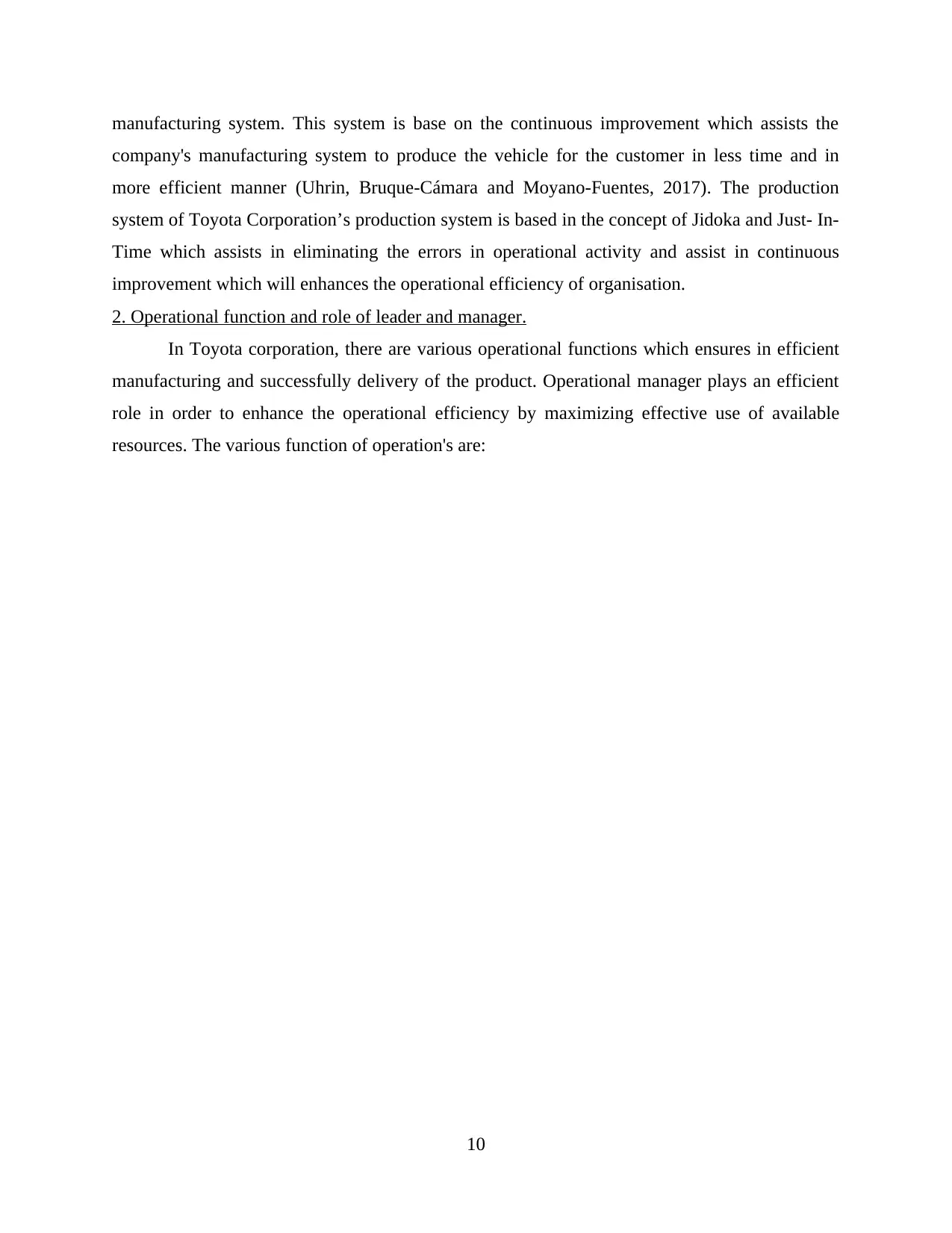
manufacturing system. This system is base on the continuous improvement which assists the
company's manufacturing system to produce the vehicle for the customer in less time and in
more efficient manner (Uhrin, Bruque-Cámara and Moyano-Fuentes, 2017). The production
system of Toyota Corporation’s production system is based in the concept of Jidoka and Just- In-
Time which assists in eliminating the errors in operational activity and assist in continuous
improvement which will enhances the operational efficiency of organisation.
2. Operational function and role of leader and manager.
In Toyota corporation, there are various operational functions which ensures in efficient
manufacturing and successfully delivery of the product. Operational manager plays an efficient
role in order to enhance the operational efficiency by maximizing effective use of available
resources. The various function of operation's are:
10
company's manufacturing system to produce the vehicle for the customer in less time and in
more efficient manner (Uhrin, Bruque-Cámara and Moyano-Fuentes, 2017). The production
system of Toyota Corporation’s production system is based in the concept of Jidoka and Just- In-
Time which assists in eliminating the errors in operational activity and assist in continuous
improvement which will enhances the operational efficiency of organisation.
2. Operational function and role of leader and manager.
In Toyota corporation, there are various operational functions which ensures in efficient
manufacturing and successfully delivery of the product. Operational manager plays an efficient
role in order to enhance the operational efficiency by maximizing effective use of available
resources. The various function of operation's are:
10
⊘ This is a preview!⊘
Do you want full access?
Subscribe today to unlock all pages.

Trusted by 1+ million students worldwide
1 out of 24
Related Documents
Your All-in-One AI-Powered Toolkit for Academic Success.
+13062052269
info@desklib.com
Available 24*7 on WhatsApp / Email
![[object Object]](/_next/static/media/star-bottom.7253800d.svg)
Unlock your academic potential
Copyright © 2020–2025 A2Z Services. All Rights Reserved. Developed and managed by ZUCOL.





